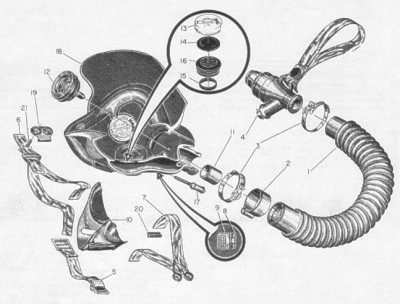The mask
nomenclature and specs for A-13A/MS22001 masks are probably more
confusing and complicated than the P-series particulars. The
'dash' numbers -1, -2, & -3, in reference to the MS22001
mask referred to small, medium, and large face pieces. This
comes from a reference dated 1965 from Sierra Engineering , and
these numbers (the dash numbers) are not strictly correct for
MC-3 or MC-3A connector equipped MS22001 masks (only for masks
fitted with the MS27796 3-pin connectors).
 |
Parts
list:
1. Breathing tube
2. Cable guide
3. Hose clamp
4. Connector assembly
5. Nosepiece strap
6. Hook strap
7. Strap assembly
8. Catch
9. Adapter & buckle assembly
10. Nosepiece
11. Insert
12. Exhalation valve
13. Valve cover
14. Flapper valve
15. Band
16. Valve seat
17. Microphone plug
18. Face piece
19. Spring hook
20. Clincher tip
21. Screw |
A reference
dated 1970 is slightly different again. The A-13A mask and the
MS22001 masks of the early 50s were essentially the same in
terms of function, and certainly similar in all functional
details except for items such as the suspension straps and
connectors. Originally, the A-13 mask had a standard WWII type
friction fit connector on the end of the hose. This was similar
to the WWII Luftwaffe's 02-mask hose attachment system. It also
had a standard constant flow system type connector fitted to a
junction at the proximal end of the hose, between the face piece
and hose. An emergency H-1 and H-2 type bailout bottle supplies
could be attached. This was soon thereafter eliminated (late
40s) by a modification to combine both emergency bailout bottle
hook-up and aircraft main 02 supply inlet in a single connector
fitted to the end of the hose. The Navy's ACEL pioneered this
type of connector and it was adopted by both services (this was
the USN BUAER spec 83-C-3 connector, designated 191A2). The new system was found
to be much better than anything previous used. When it was found
that connectors of this type were sometimes pulling loose from
the female 02 hook-up receptacles unbeknownst to pilots (and
thereby causing potentially fatal LOC due to hypoxia
situations), the design was modified with a disconnect warning
valve device built into the connector. This resulted in the type
MC-3 connector designation. All of these connectors featured a
nylon snap-fitted strap that could be secured to prevent flail
to some degree. Pictures of the different types of
connectors may be found
here.
A still further minor redesign of the emergency disconnect valve
device resulted in the designation MC-3A (also known as the
MS22016 connector). Although at first glance all of these
connectors appeared similar to each other (there were variations
in the colour of the anodised aluminium parts -- early
191A2 non-warning type connectors featured green anodisation, while
later warning type connectors featured red or in some cases
white anodisation). None of
these early connectors incorporated suitable anti-flail features
to keep hoses from inflicting windblast flail impacts on the
pilots in emergency ejection situations (the nylon strap system
was not always effective). This problem was rectified by
development of system wherein an internal nylon cord connected
the mask's distal facepiece connector to the distal hose
connector; however this was a feature that only the MS22001 mask
fitted with the new 3-pin connector had. The 3-pin connector
attached to a chute harness connector which stayed with the
pilot (this was the CRU-8/P, later replaced by the improved
CRU-60/P, which incorporated both emergency disconnect valving
and emergency bailout 02 hook-ups). Very early 3 pin.connectors,
designated 57B3661,
were machined from a single piece of bright aluminium and had
squared off pins. A close examination will reveal this. Later
versions, designated MS27796, featured round pins and refined machining techniques
(as a result, these early bright aluminium 3-pin connectors are
rarer and more valuable to a knowledgeable collector).
The addition of the 3-pin connector to the hose of a mask, the
use of a different length hose, or the use of a different
helmet-to-mask suspension strap arrangement, all resulted in
redesignation by different specific identification and spec
numbers. Thus there were the different A-13A, the MS22001, the
MBU-3/P, etc., masks, although in every case the actual mask
itself and its function remained essentially the same (except
for incidentals, such as have just been referred to). It was
also pointed out in a previous commentary that the A-13A and
early MS22001 masks could be used with a standard one-way rubber
check exhalation valve. As that used in the demand mask type
A-14 and its variants. They are sometimes (although
infrequently) still found with this type of exhalation valve
fitted, instead of the positive pressure breathing exhalation
valve that was used almost universally in masks of this type
from the mid-50s onwards. It is suspected that the MS22001 mask
was also used as an emergency demand type mask in certain
aircraft, so this might also have resulted in the substitution
of an ordinary one-way exhalation valve in an MS22001 or A-13A
mask for the pressure-demand valve.
Note: "This article
is tentative, and informal account, and as yet not complete; the
information appearing here is not intended to serve as a final,
definitive, or authoritative reference to the MS122001 or A-13A
mask. A more refined, more complete, and more accurate version
is required and may be available in future, upon accomplishment
of cooperative collaboration with others (Principally Steve
Norris, who is presently in the process of researching this and
related areas of concern for his upcoming book on these
systems)". |